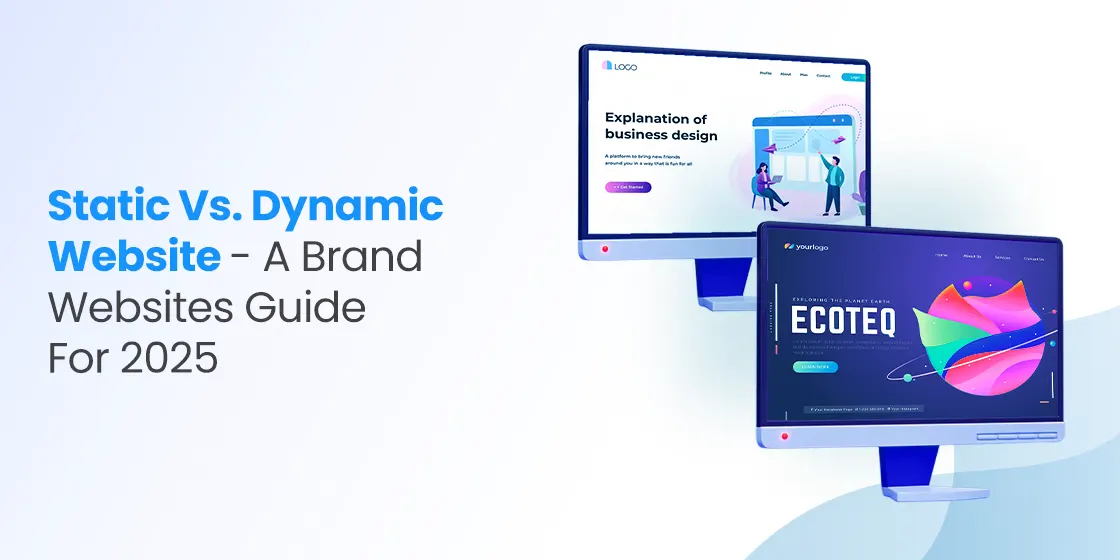Table of Content
Discover the Difference Between Static vs. Dynamic Website for Your Business
These days, a brand’s website serves as its virtual storefront, and a crucial touchpoint for engaging with customers and building brand identity. Choosing the right website architecture is fundamental to achieving these goals. Two primary approaches exist: static and dynamic websites. Understanding the distinctions between these approaches is critical for making informed decisions about your brand’s online presence in 2025 and beyond.
Static websites are like digital brochures, presenting pre-built, and unchanging content to every visitor. Think of a beautifully designed pamphlet – the information is fixed and readily available. Dynamic websites, on the other hand, are interactive and adaptable. They generate content on the fly, responding to user input and offering personalized experiences. Imagine a choose-your-own-adventure book – the story changes based on your choices.
In this guide, we will dive into the intricacies of static and dynamic websites, exploring their characteristics, pros, cons, and ideal use cases as per professional web development services. By understanding the nuances of each approach, you will be able to determine which website architecture best aligns with your brand’s objectives, target audience, and long-term digital strategy.
Let’s begin.
What is a Static Website?

Let’s start with the simpler of the two options in static vs. dynamic websites – static websites. Static websites are built using HTML, CSS, and JavaScript files that are stored on a server. When a user visits a static website, the server simply delivers these pre-built files to the user’s browser, which then renders the content. This process is fast and efficient, as the server doesn’t need to perform any processing or database queries.
Static websites are characterized by their simplicity and speed. Because the content is pre-generated, they load quickly, providing a seamless user experience. They are also relatively easy to develop and maintain, making them a cost-effective option for smaller businesses or websites with limited content updates. Static websites are often used for landing pages, portfolio website examples, and simple informational websites.
What is a Dynamic Website?

Dynamic websites, in contrast, utilize server-side scripting languages (like PHP, Python, or Node.js) and databases to generate content dynamically. When a user visits a dynamic website, the server processes the user’s request, retrieves data from the database, and generates the HTML page on the fly. This allows for personalized content, interactive features, and real-time updates.
Dynamic websites are more complex than static websites but offer greater flexibility and functionality. They are ideal for websites with frequently updated content, such as e-commerce stores, blogs, and social media platforms. Dynamic websites also enable user authentication, personalized recommendations, and other interactive features, making for some creative website design ideas.
Key Differences Between Static vs. Dynamic Websites
While understanding the difference between static vs. dynamic websites seems simple, its only when you compare the common factors side-by-side do you see the true picture. Therefore, let’s take a comparative look at the differences between static and dynamic websites today.
| Feature | Static Website | Dynamic Website |
| Content | Pre-built, unchanging | Generated on the fly |
| Technology | HTML, CSS, JavaScript | Server-side scripting languages, databases |
| Speed | Fast loading times | Can be slower depending on complexity |
| Development | Simpler, less expensive | More complex, more expensive |
| Maintenance | Easier to maintain | More complex to maintain |
| Scalability | Can be scaled easily | Scalability depends on server infrastructure |
| Interactivity | Limited interactivity | High interactivity, personalized experiences |
| SEO | Can be optimized for SEO | Requires careful optimization for SEO |
| Security | Generally more secure | Requires robust security measures |
Choosing the Right Website for Your Brand

The choice between a static and dynamic website depends on several factors:
- Content Updates: If your website content changes frequently, a dynamic website is the better choice. For websites with minimal updates, a static website may suffice.
- Interactivity: If you need interactive features like user logins, personalized recommendations, or e-commerce functionality, a dynamic website is essential.
- Budget: Static websites are generally less expensive to develop and maintain than dynamic websites.
- Technical Expertise: Maintaining a dynamic website requires more technical expertise than maintaining a static website, with various popular backend frameworks requiring different skills.
- Scalability: If you anticipate significant growth in website traffic, a dynamic website offers better scalability options.
Static Site Generators: A Modern Approach

For brands seeking a balance between simplicity and functionality, static site generators (SSGs) offer a compelling alternative. SSGs allow developers to write content in markdown or other formats and then generate static HTML files during the build process. This combines the speed and simplicity of static websites with the flexibility of dynamic content creation.
SSGs are a good choice for blogs, documentation sites, and marketing websites that require frequent content updates but don’t need complex interactive features. Popular SSGs include Gatsby, Next.js, Hugo, and Jekyll.
The Future of Brand Websites
In 2025 and beyond, brand websites will continue to evolve, driven by advancements in technology and changing user expectations. We can expect to see:
- Increased Personalization: Websites will leverage data and AI to deliver highly personalized experiences to each visitor.
- Enhanced Interactivity: Websites will become more interactive, offering features like chatbots, virtual tours, and augmented reality experiences.
- Greater Accessibility: Websites will be designed with accessibility in mind, ensuring that everyone can access and use them regardless of their abilities.
- Seamless Integration: Websites will be seamlessly integrated with other digital platforms, such as social media, e-commerce platforms, and CRM systems.
Conclusion
Choosing the right website architecture is a critical decision for any brand. By understanding the differences between static vs. dynamic websites and considering your specific needs and goals, you can create a website that effectively represents your brand and engages your target audience.
In the future, we can expect to see even more innovative website architectures and features emerge, driven by advancements in technology and the ever-evolving needs of users. By staying informed about these trends, you can ensure that your brand’s website remains relevant and effective in the years to come.

Empower your digital journey with StruqtIO - Your dedicated partner for cutting-edge custom software development, innovation, and digital transformative solutions. Harness the power of technology to elevate your business and redefine your digital landscape today.



